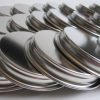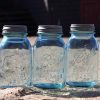There are two types of recommended canners that can be purchased to process foods — boiling-water canners and pressure canners. Most of these are designed to hold seven quart jars or eight to nine pints. When models are small they are designed to hold four-quart jars. Large models can hold eighteen pint jars in two layers or seven quart jars in one layer.
Low-acid foods must be processed in a pressure canner to ensure safety and lowest chance of botulism risks. Acid foods can be processed in either boiling-water canners or pressure canners; boiling water canners are recommended however due to a shorter processing time.
Boiling-water Canners
Boiling-water canners are made of aluminum or porcelain-covered steel. They have fitted lids and removable perforated racks. When choosing a boiling water canner to purchase make sure that it is deep enough so that at least one inch of briskly boiling water will be over the tops of jars during processing. *Note: if you are working with an electric range you must purchase a boiling-water canner with a flat bottom. Not all boiling-water canners have flat bottoms. Also make sure that the canner is no more than 4 inches wider in diameter than the electric element on which it is heated. If you have a gas burner you can use either a ridged bottom or a flat bottom.
Pressure Canners
Pressure canners are made lightweight with thin walls and most have turn-on lids. They have a jar rack, gasket, dial or weighted gauge, an automatic vent or cover lock, a vent port to be closed with a counterweight or weighted gauge, and a safety fuse. *Note: only purchase pressure canners that have the Underwriter’s Laboratory (UL) approval to ensure their safety.
Weighted-gauge models… (p.20)
Canning Jars
Canning jars are one of the most important pieces of equipment in canning. When choosing jars the Mason-type, threaded, home-canning jars with self-sealing lids are the best choice. These types of jars can come in a variety of sizes including:
- Jelly (4 ounces, 118 mL)
- ½ pint (8 ounces, 236 mL)
- Pint (16 ounces, 473 mL)
- 1-½ pint (24 ounces, 710 mL)
- Quart (32 ounces, 946 mL)
- ½ gallon (64 ounces, 1,892 mL)
There are two different opening diameters to glass home-canning jars. One is known as standard and one as wide mouth. The standard mouth jars have an opening about 2-⅜ inches wide. The wide mouth jars have an opening about 3 inches wide which makes them easier to be filled and emptied.
When jars are handled properly they can be reused many times with new lids. Proper handling includes appropriate cleaning, sterilizing, packing and cooling.
Canning Lids
The most common and recommended lid type is the self-sealing lid. These lids consist of a flat metal lid held in place by a metal screw band during the canning process. There is a colored gasket compound on the underside of the flat lid, which is crimped around its bottom edge to form a trough for the compound. During the canning process the lid gasket softens and covers the rim but still allows air to escape from the jar. It then forms an airtight seal as the jar cools. These lids can be saved for use for up to five years from the manufacture date as long as they have not been used before; all used flat lids should be discarded after use. Lids over five years from the manufacture date may have gasket compound that fails. To ensure quality lids, only purchase the number of lids you think you will use in a year.
Canning Ladle
Canning ladles are beneficial for ladling hot water into jars before processing. They can also be used to move hot-packed food from a saucepan into jars. Their long handles keep your hands safe and the pre-measured ladles make measuring quick and easy.
Canning Funnel
Canning funnels are beneficial for filling jars without creating a mess. The wide opening of these funnels allow for the transfer of liquids and solids.
Canning Headspace Tool
Canning headspace tools are used to help measure headspace and pop bubbles between the food and the jar sides before processing.
Jar Lifter
Jar lifters are used to place jars in canners and remove hot, processed jars from canners. Some are spring loaded which will improve strength and spring open automatically while others are manual. Look at reviews to see which products are best for different sized jars.
Towel
Towels can be used for wiping down the jars after removing them from the canner and/or placing processed jars on to cool.
Racks
Racks can be used for cooling the jars after processing.
Vegetable Oil
Vegetable oil is used to oil the gaskets on older models of pressure canners once a year. Gaskets on newer model canners are pre-lubricated and do not benefit from oiling.
Permanent Markers
Permanent markers can be used to label jars after processing. Labeling jars is important so that you can keep track of age of food and potential spoilage.
Blankets
Blankets can be used to insulate jars if storing in a cold location. Freezing and thawing may soften food so it is best to insulate the jars with heavy blankets inside of crates.
Cartons
Cartons can be used to hold jars in storage. If storing in a cold location place jars inside of the cartons and wrap newspapers and blankets around them to prevent freezing.
Canning or Pickling Salt
Canning or pickling salt is used to preserve pickles and fermented foods. It is a pure sodium chloride that does not contain iodine, keeping pickles their crisp color without darkening and does not contain anti-caking ingredients which can cause clouding.
White Granulated Sugar
White granulated sugar can also be used for preserving pickles and fermented foods.
Brown Sugar
Brown sugar can also be used for preserving pickles and fermented foods.
White Distilled Vinegar
White distilled vinegar can be used in preserving pickles and fermented foods. It can also be used to increase the acidity of foods while canning.
Cider Vinegar
Cider vinegar can be used in preserving pickles and fermented foods. It can also be used to increase the acidity of foods while canning.
Food-grade Lime
Food-grade lime or pickling lime can be used to create a lime-water solution for soaking cucumbers for 12-24 hours before pickling them. *Note: if too much lime is absorbed, remove the excess lime by draining the lime-water solution, rinsing the cucumbers, and then re-soaking them in fresh water for an hour. This will make them safe for processing.
Candy or Jelly Thermometer
Candy or jelly thermometer can be used to check the water temperature while firming up pickles before canning.
Pectin
Pectin is used to form a gel when combined with the right amount of acid and sugar and is most often used in the processing of jellied fruit products.
Modified Pectin
Modified pectin comes in two varieties. One variety will gel with one third less sugar while the other requires a source of calcium to gel.
Splenda
Splenda is the only sweetener that can be added to the liquid or “covering liquid” before it is added to fruit products.
Equipment for Detoxifying Spoiled Canned Food
If your canned goods end up spoiled they must be detoxified before being disposed of. Some materials to help with the detoxification process are listed below.
Rubber or heavy plastic gloves– these sorts of gloves or other personal protective equipment should be used when handling the contaminated food.
Can opener– can be used to open cans if you processed in cans instead of jars.
Apron– an apron or spare clothing should be warn to protect your skin while working with contaminated foods.
Spray bottle– used to hold a bleach solution for cleaning up the contaminated materials and surfaces.
Chlorine bleach– used with water to make a solution for cleaning up contaminated materials and surfaces.
Paper towels– used to wipe up treated spills.
Plastic bags– used to bag up soiled paper towels, materials and contaminated waste before placing the waste in the trash.
Trash bags– used to dispose of bagged, contaminated materials.


